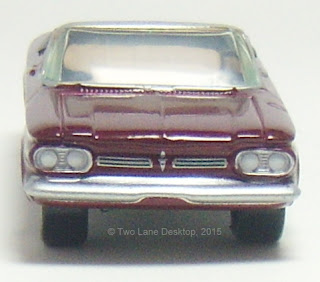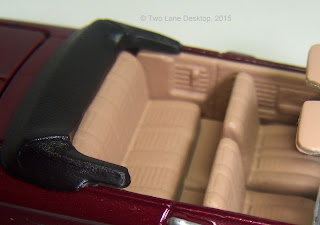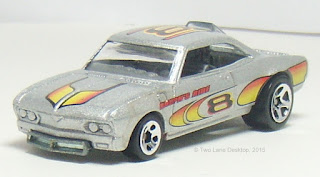The Chevy Corvair's of Hot Wheels, Johnny Lightning, and Racing Champions
While often a car misunderstood by the general public and given a bad rap sheet thanks to Ralph Nader's "Unsafe at Any Speed" controversy, the Chevy Corvair still continues to gain support from collectors and a select few individual who consider Chevy's first compact cat to be a technical marvel; and I agree though I also think GM never really thought through this car carefully before production, especially the swing-axle rear-end (more on that later). Nevertheless you can find replica's of this casting, but beware as they tend to disappear rather quickly not because of demand but because these castings somehow only last for a brief while. Joining the lineup of Corvair's this year includes the wild Greenbrier Sports Wagon, which is a van based on the Corvair in the 1960's.
Click Here for Photo Gallery
Was it the VW Beetle or was it the size of American cars in the 1950's that made American automakers push toward smaller cars? It remains to be unseen the true answer, but likely it was both of them as American automakers only made large cars and imports like the Beetle was getting far more popular than expected, plus most buyers who are working their first job do not want to deal with the size and price of a new large car, or prefer to have a more fuel-efficient manuverable vehicle. So, cars like the Corvair, Ford Falcon, and Plymouth Valiant were created to start an entry point in the Big 3 lineup. The Corvair, unlike the others, was unique as it had a rear-mounted, air-cooled 2.3L flat-six like the VW Beetle but with two extra cylinders, producing 80 hp. through a three or four speed manual or two-speed automatic. The body was the first unibody design built by Fisher coachworks; the cabin roomy with lots of legroom; and the trunk was ample as well thanks to the spare tire and jack located with the rear engine. But then problems started to surface when Nader got on the car for its swing rear axle that lacked any stabilizer bars and required unequal tire pressures on the rear tires to counteract the handing woes. This resulted in a class-action lawsuit and tarnished the Corvair nameplate even after the rear suspension was fixed in the second-generation model, which featured more power and more swept-back styling.
Click Here for Photo Gallery
My first Corvair diecast model was this Racing Champions version in avocado green on green color scheme. The front uses the same quad headlights in the round retainer, but has integrated vents as there is no front grille, just the V logo, chrome bumper, and the lower ribbed section below the bumper. The sides are simple with a few chrome trim details and gascap door and driver's side rearview mirror on the left-side of the vehicle. The rear has quad round taillights, chrome bumper, and vented rear engine panel. Opening the hood reveals the silver flat engine block and black air filter housing, but lacks the spare tire and rear jack, while the base shows the underside of the engine detailing and the suspension details on a chrome metal base that is rather thin and, like other Racing Champions Mint castings, can be prone to metal fatigue. The interior features a silver dash top with dual pod design, comprehensive gauges behind the 2-spoke steering wheel, front and rear bench seats that feature the same pattern design as the door panels. To top it off is the chrome hubcaps on narrow tires. It's simple but gets to the point!
Click Here for Photo Gallery
Next up is the Johnny Lightning 1962 Corvair Spyder, introduced in 2007 and the latest Corvair casting in my collection to date. Like the Racing Champions version it gets straight to the point with its simple design and opening rear engine panel, but adds more detail and flair to the car. The front has the same detailed quad headlights and front bumper and now adds vent grilles to the center. The sides add more logo's and cool-looking Craiger mag wheels, while the rear has more detailed taillights with silver trim accents, chrome bumper that meets the lower head shield, and smaller vents on the rear engine panel. Drop the top and add maroon on tan color scheme and this is one fine looking car that looks more high-end than it should be. The interior shows more of the twin-cockpit dash layout, 2-spoke steering wheel, door panels, and front and rear bench seats, but also adds the black tonneau cover over the convertible top. The metal base underneath has a thicker metal body construction with similar engine details that interestingly enough has a bit of detail to the auto transmission's oil pan. The engine cover opens to a real treat as the air-cooled six has a smaller air cleaner, detailed engine block with the twist belt that transfers crankshaft power 90 degrees to power the fan on top, blue battery on the left, and a spare tire on the right. Johnny Lightning has given careful detail on this casting, especially in the engine bay, and how cool was it for me to find my second White Lightning based on this car!
Click Here for Photo Gallery
Not enough power? Check out the Hot Wheels version of the 1965 Corvair Monza coupe, the Vairy 8 casting released in 2003. First, it has the new sleeker look with aggressive front-end with spear-shaped headlight frames and a new rear valence panel that has the quad taillights more recessed into the panel. Then add the raked rear and low front stance, detailed headlights, and lower bumper scoops. The rear engine cover has more louvers (and here I thought the 1959 Chevy Panel van was the first to have this!), quad taillights, and a license place area that also serves as the metal base tab. Yes, you heard right, this car has a metal base with rivet details at the front and just ahead of the rear axle and beefy tires is a large engine block with headers and an oil pan that is part of the interior. If you haven't seen the roof scoop and the shape of the rear window you'd already notice the change in engine placement: it is now in the center of the car just behind the front bucket seats, and it is believed to either be a flat-six or flat-eight with detailed engine block and check out those carb stacks in the back towering up toward the roof! Incredible! Other colors include the flat green, blue, and black that have a nice salute to the World War II aircraft, but how can you go wrong with the first silver release with a humorous nod to Ralph Nader on the side! As usual the metal base of this casting has limited it to just premium lines, and even with that it has not gotten much use as of late.
Click Here for Photo Gallery
But that's ok because Hot Wheels has another wild Corvair to deal with, this time with the Greenbrier Sports Wagon for 2015. Just like Vairy 8 the van has a lower front and raked rear stance, large detailed flat-six engine that includes the side air filters leading to the tall intake runners, valve covers, and engine fan connected to the drive belts. However, unlike Vairy 8 the only identifier to the Greenbrier is the front-end with the quad headlights and grille detailing The sides get the flow-back window posts similar to the Surfin' School Bus and lacks the right-side rear doors for a smooth look, while the roof-mounted surfboards are cool but need to be a separate piece from the body. The rear engine and large rear wheels on rubber tires manage to take over the rear bodywork void of any rear window or taillights. The base, like the body, has most focus on the rear engine and is made out of metal to make this one heavy casting, though it ranks behind the VW Drag Bus and a few Semi Tractor Cabs. The interior has front seats with a dash layout that includes the dash-mounted racing tachometer, yet the rear is wasted space for a van as it only has a few rollcage bars and that's it! While cool-looking at first, this casting will wear off after a while when many collectors yearn for a stock-looking Greenbrier Sports Wagon.
Click Here for Photo Gallery
Hopefully someday along with a stock Wagon and Pickup we can also see more Corvair's, especially the second-generation.























































Comments
Post a Comment